It wasn?t so long ago that stand-alone headphone amps were pretty much unheard-of, or that home headphone listening went no further than plugging the input jack in on the front panel of your amp.
On the back of the amp, a simple divider bridge made from resistors controlled the level of voltage which was sent to the headphones.
Simple as it was, this solution made it possible to reproduce the amp sound for headphone listening. But the whole set-up was voraciously wasteful of energy: the listener needed to power an amp which was losing more energy to resistance than it was using to produce the sound.
Headphone amplifiers seem to offer the solution to this problem: their power supply is designed with the relatively low power needs of most headphones (a few hundred mW at most), to deliver improved audio levels straight to the user?s ears.

However, it is still possible to do what NuForce have done with their new HA 200 headphone amp: combine high-end (or Class A) amplification, which wastes a lot of electricity as heat, with relatively high power. This makes it possible to overcome various problems and achieve a great level of sound on certain headphones ? and the result is a device with a power consumption of nearly 25 watts!
But that?s not all. NuForce seem to be looking for some extra fun, so they have fitted the HA 200 with a balanced input, so that it can produce a balanced mono audio signal, amplified over a female XLR connector, mounted on the front panel, alongside a 6.35mm stereo input jack for classic stereo mode.
That means that to listen to balanced sound in stereo, you would need to use two separate channels, which would bring overall power consumption to 50 W! This isn?t exactly eco-friendly, but when your headphones just don?t respond to namby-pamby little amps, extreme measures are called for.

Let?s take a look at this turbo-charged HA 200 amplifier.
Appearance
Understatement, sobriety ? these are terms that could describe the appearance of the NuForce HA 200, whose anodised aluminium front panel comes with either a silver or black finish.
There is a volume knob at the right end, a standard 6.35mm headphone input jack at the other, and to the right of that, a three-pin female XLR connector (designed for total audio balance mode), which is masked with a cover which we think doesn?t make for the best aesthetic effect.

?Connections
Nothing could be simpler ? but NuForce has complicated things by adding a balanced XLR input for Balanced Headphone Mode, with an HA 200 for each channel, with output via the XLR socket on the front panel, with an unbalanced stereo input via cinch plugs allowing for ?standard? stereo functioning.

?Construction
As ever with NuForce the workmanship is serious. If nothing else, the sheer weight of the HA 200 is very reassuring ? it actually feels more like a small traditional amp than like a model designed for headphones!
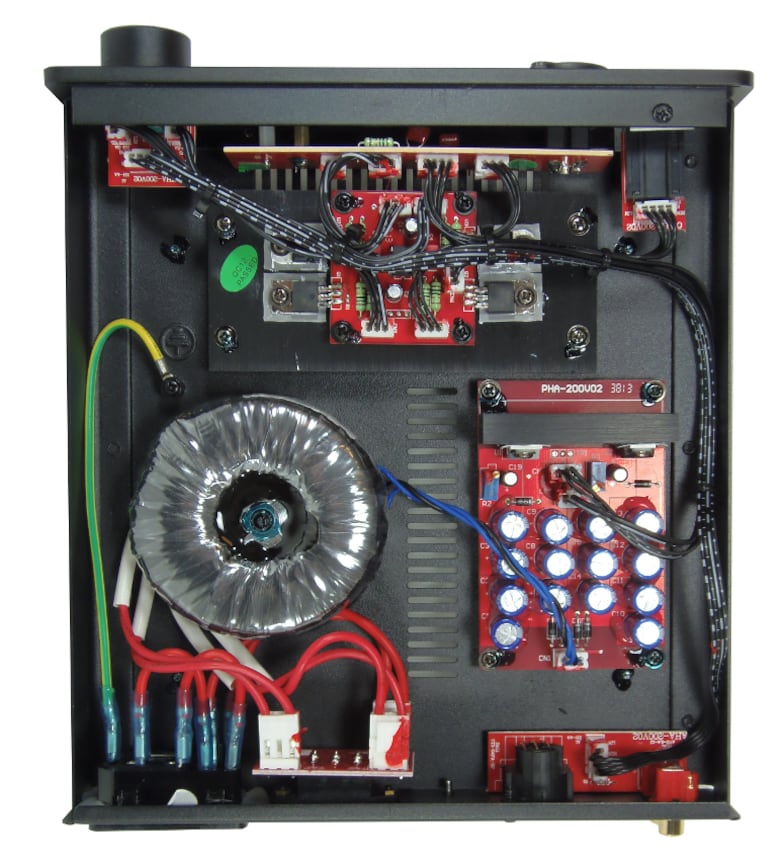
Don?t let the HA 200 label on the outside fool you: the size of the power supply?s toroidal transformer, and the 25VA punch it packs would be pretty well-suited to powering an amp with a wattage of several watts!
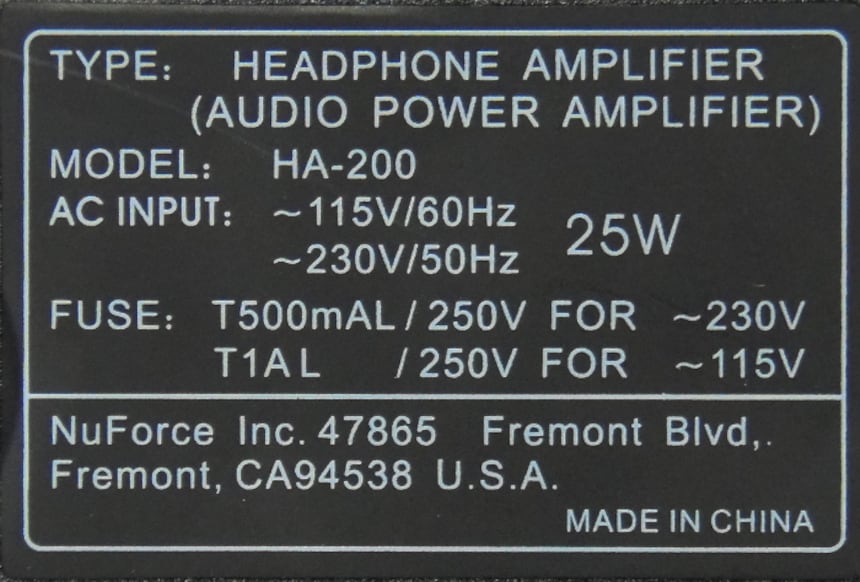
The housing is particularly solid too, with an undercarriage made from a single folded steel plate, which has been stamped on its undersides to create grooves for the top cover, which slides along in them like a desk drawer to close the HA 200.
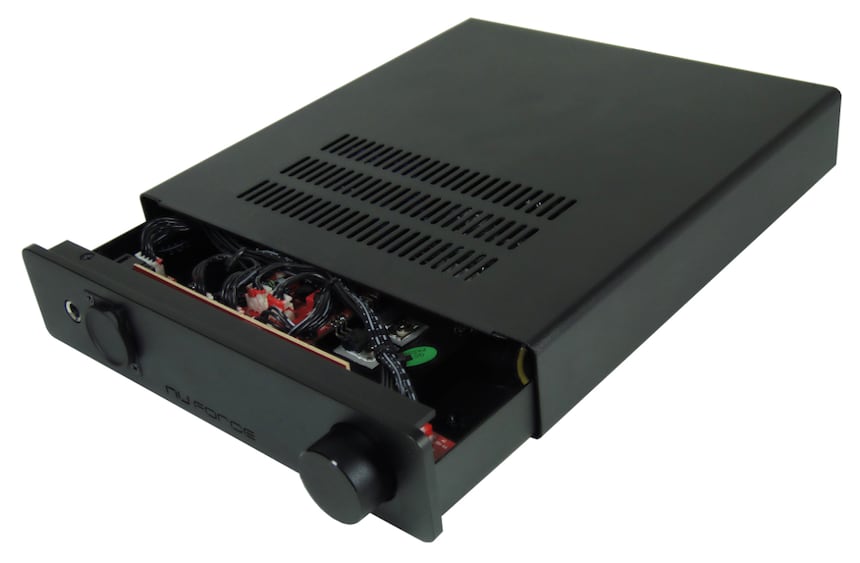
?Power supply
To power a pure Class A amp, you need a power supply that you can rely on. The HA 200 power supply, at 25 watts, is linear and balanced, and designed so as to avoid the use of capacitors on the signal path. An LM317 on the positive side and an LM337 on the negative side regulate the voltage. These regulators are mounted on a solid anodised aluminium heatsink, because when pure Class A amplifiers are in operation, a constant load is placed on the power lines, and they get hot!
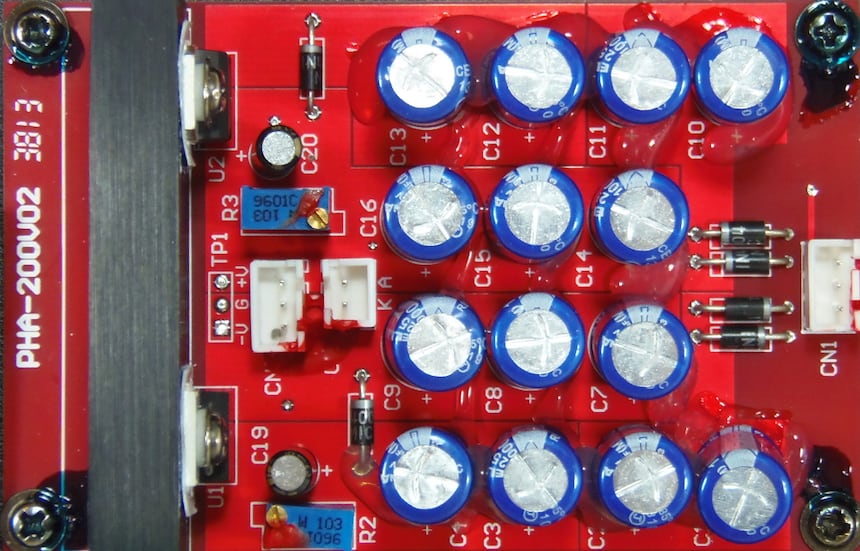
Fourteen 1000 ?F/25V Elna brand capacitors help filter the power supply, and form a large energy reserve which can meet the amp?s current demands during dynamic load peaks.
Amplification
Each gain path in the HA 200 uses a power unit working at pure Class A level, whose output is taken into the feedback loop of a Burr-Brown OPA2134 operational amplifier, which results in a voltage gain of 2 (i.e. 6dB, according to our study) and not 10dB (i.e. a gain of roughly 3.2), as NuForce claims.
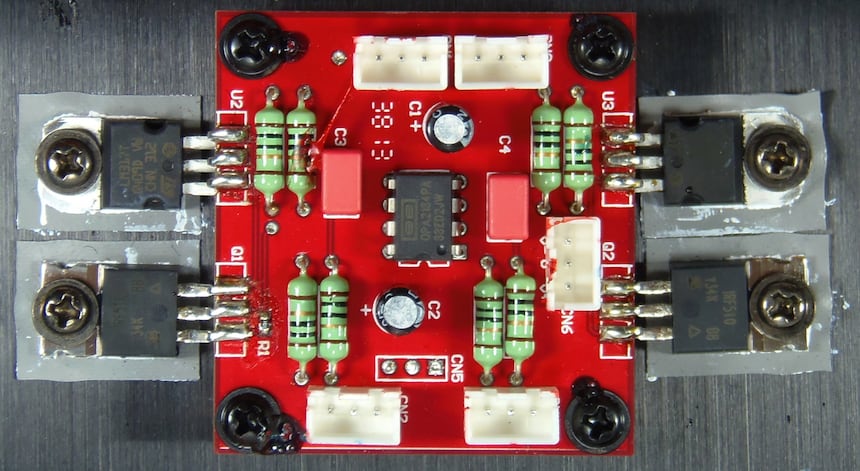
If you divide the image above in two with an imaginary vertical line, the two halves are identical.
On either path, the amplification of power (that is, the ability to deliver current) is passed into a MosFet IRF510 transistor, whose source current is set at 250mA, by a constant current source which is based on an LM317 circuit.
This strong bias current makes it possible to set the transistor?s ?bias point? (see note at the end of the article) in the centre of the active region of the transistor characteristic ? thereby making it possible to amplify signals without distortion.
A bi-product of this process is significant heating, even where there is no signal, and transistors which are the source of constant current are mounted on a large heatsink, which is made from black anodised aluminium.
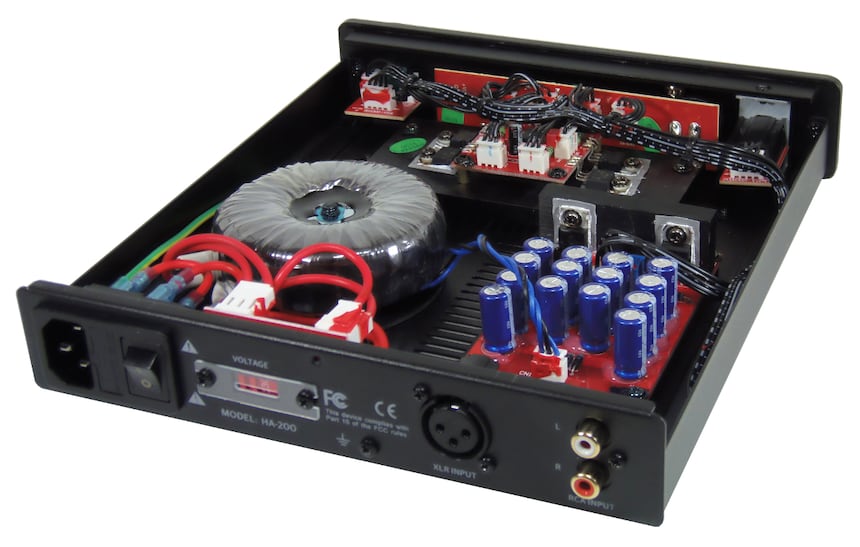
?Let?s take a look at what NuForce has to say about biasing amplifying transistors using the Nuforce (§ Constant Current Output): ?The Constant Current topology has the ability to constantly adjust output voltage as the headphone impedance changes with frequency ...?
Now, maybe we just don?t understand how constant current transistor biasing works. It could be that we don?t get how a constant current generator works inside an assembly, either. But what NuForce is saying here would suggest that the signal which is sent to the headphones will not follow the dynamic content of the input signal, as its range will adapt to the changes in headphone impedance, which is pretty troubling, because it means that the output will never match the dynamic content of the input?
A very simple calculation can show that this is wrong, and that what NuForce say on the matter is mistaken.
If at a given frequency a headphone presents, for example, an impedance of 300 ? (we?ll assume a headphone with a high impedance because the HA 200 was basically invented to deal with them specifically), if the constant current is 250mA, a voltage of 250mA x 300 ? will be delivered to the headphone terminal (using Ohm?s Law V = R x I). That?s 70V, which is enormous and far exceeds the voltage of the overall power supplied by the HA 200?s power unit (which is a little over 30V).
We are pretty confident that a source of constant current maintains the current at a level of charge which has been set in advance on the basis of the requirements of the assembly, and that in this case that is determined by the amplifying transistor and not by the headphone transducer coil, which reflects the transistor amplifier charge.
The variations in current in the amplifying transistor output, which are created by the input signals, will not alter the bias point which was fixed by the source of the constant current. Rather, they will generate amplified signals based on the input signals, which are centred around the bias point.
These amplified signals are fed into the headphone?s loudspeaker in order to produce sound.
So who wrote NuForce?s notes on biasing a transistor using a constant current generator?
Balanced Headphone Mode
It seems that balanced lines (and the craze for them) hadn?t made it as far as headphones. Clearly, they have now. The aim here is to provide a decent level of power across high-impedance headphones. This is difficult because high-impedance headphones require high-amplitude signals. The same goes for low-impedance headphones which need a lot of power due to their low output, like some Hifiman headphones which use ?planar? transducers.
So to carry this off, two HA 200s are needed, each connected to a balanced signal source by balanced leads, with an XLR plug.
This means that each of the two HA 200s will work entirely in mono, in balanced audio mode, from the input to the headphone output, which is sited directly opposite, on the front of the amp.
However, this requires a headphone set which can carry the two signals on the left and right sides separately over two separate leads. That means that headphones with a fixed lead fitted with a three-pin jack plug will not be able to function in this mode.
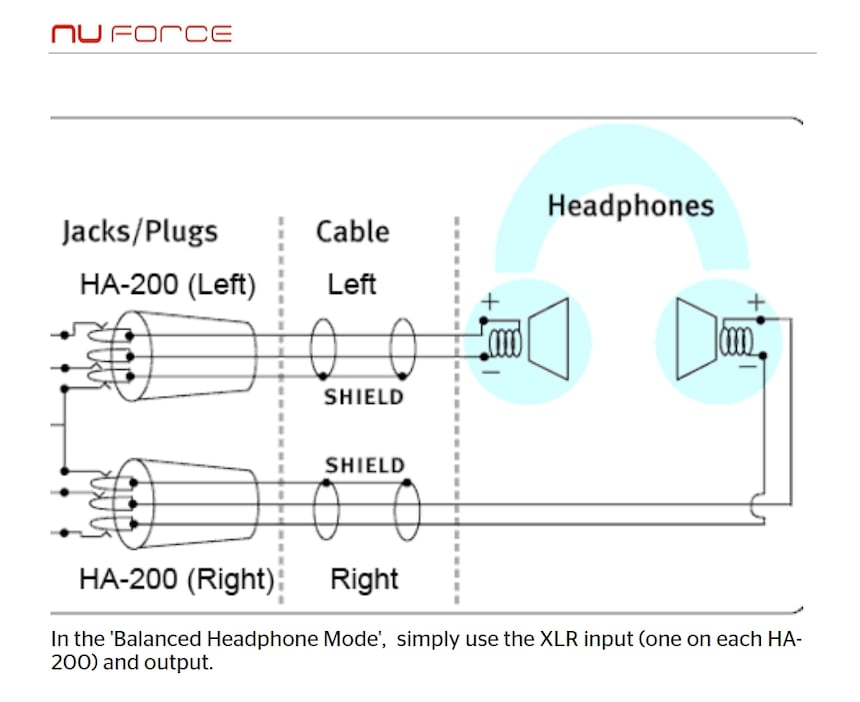
We don?t know if headphones exist which are designed for a balanced connection over two cables, with leads with the appropriate connectors ? but a welding enthusiast could surely make one for their own headphones, and XLR-6.35mm stereo jack adaptors can be got, which would fit ?big? Sennheiser headphones, which use two standard leads, one on each side.
But, as the Shadoks would say, why do anything the easy way when you can do it the hard way? This ?Balanced Headphone Mode? option has certainly got us scratching our heads?
Listening
At the request of Next Audio, NuForce?s importer, Son-Vidéo.com lent us a ?planar? Hifiman HE-500, which can be a bit difficult to drive, so that we could appreciate the HA 200?s abilities in this regard.
Whatever we might have to say about NuForce?s somewhat inexact notes about biasing a transistor with constant current, and our doubts about Balanced Headphone Mode, well, when you stick the headphones on and start listening to your favourite tracks using the HA 200, your jaw hits the floor.
For the record, I?ve never been a big fan of headphone listening ? but trying out a pair of Hifiman HE5-00 headphones driven by the NuForce HA200 is enough to convert anyone.
It?s great art, with a bandwidth that falls and falls, and rises and rises, with dynamic control that lets you hear every nuance, even the finest details. The playback is so perfect that you want to turn the volume right up: the HA 200 is an anti-social influence!
Listening to the 24 bit/96kHz version of Georgio par Moroder from the album Random Access Memories by Daft Punk was a real decibel explosion: I felt like I?d never heard the piece played at such quality before.
I had the same experience when I listened to Papaoutai off Racine Carrée by Stromae, with a level of definition, clarity and presence that was just astonishing.
And even with a cheap hand-me-down Koss Porta Pro headphone, you can spend many happy minutes listening to Pars Tertia from the sublime religious Mors et Vita trilogy by Gounod, at sound levels which would horrify Ear, Nose and Throat specialists and have hearing-aid merchants rubbing their hands in glee.
And ? believe us ? reproducing and listening to a roughly 200-piece ensemble orchestra at high volume on headphones is no small feat. But the HA 200 makes light work of it (even on a Koss Porta!).
And while we were putting the temporal world (of electronics) to work in the service of the sacred, we tried a (very loud) little blast of Saint-Saëns?s Danse macabre for good measure, choosing the version by Charles Dutoit directing the Philharmonia Orchestra, so that we could enjoy the shrillness of violins playing in scordatura, and all the subtleties of the orchestra (even the silences!). We were bewitched!
To conclude, for all that the NuForce HA 200 headphone amp blew us away with its sound performance at very high volumes, it still left us doubting the feasibility of using its Balanced Headphone Mode, given that it involves using two units: a set-up which would create more problems in terms of finding or making the right connectors than it would solve in terms of the few difficult power supply issues which may arise. That said, in normal stereo mode, the HA 200 delivers world-class sound quality, at a very reasonable price ? which makes it very Qobuz indeed!
Note:
Biasing allows the transistor?s ?bias point? (its steady-state voltage or current when no input signal is supplied) to be set at an appropriate point to allow it to operate correctly. This determines the class of the amplifier (A, B, AB or C). (Wikipedia)
The tracks listed above were played with the HA 200, connected to the output cable of an amplifer using DAC Sony UDA-1.
??If you are a manufacturer, importer, distributor or actor in the field of sound systems and you would like to contact us, please get in touch using the following address: newstech@qobuz.com